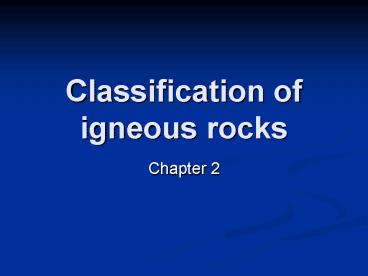Classification of igneous rocks PowerPoint PPT Presentation
1 / 21
Title: Classification of igneous rocks
1
Classification of igneous rocks
- Chapter 2
2
How to classify
- Composition
- Chemistry
- Mineralogy
- Texture/fabric
3
Classification based on texture/fabric
- Phaneritic
- Minerals large to see with naked eye
- Cooling history?
- Aphanitic
- Minerals need microscope to see
- Porphyritic 2 different grains sizes
- Cooling history?
- Phenocrysts larger grains
- Groundmass or matrix smaller grains
4
Classification based on texture/fabric
- Glassy
- Rocks with glass
- Volcaniclastic
- Minerals and rock fragments that are broken in
pieces
5
Classification based on field relations
- Intrusive
- Usually phaneritic
- Extrusive
- Aphanitic and glassy
- Many are porphyritic
- Some are volcaniclastic
6
Classification based on mineralogy
- Felsic
- Feldspar and silica
- Light colored rocks
- Mafic
- Magnesium and iron
- Dark colored rocks
- Ultramafic
- Especially rich in Mg and Fe
7
Classification based on mineralogy
- Mode of each mineral in rock
- Must add up to 100
- Quick ID of major minerals
- Choose which diagram to name your rock
8
Phaneritic rock with gt10 felsic minerals
Q
.
Quartzolite
90
90
Quartz-rich
Granitoid
60
60
- QAPF diagram
- Anorthosite gt90 plag
- Gabbro gt35 mafic mineras
- Diorite lt35 mafic minerals
Grano-
Tonalite
Granite
Alkali Feldspar Granite
diorite
Alkali Fs.
Qtz. Diorite/
20
20
Quartz Syenite
Qtz. Gabbro
Quartz
Quartz
Quartz
Monzonite
Syenite
Monzodiorite
Alkali Fs.
5
5
Diorite/Gabbro/
Syenite
Syenite
Monzonite
Monzodiorite
Anorthosite
35
90
10
65
A
P
(Foid)-bearing
(Foid)-bearing
(Foid)-bearing
Syenite
Monzonite
Monzodiorite
(Foid)-bearing
10
10
Diorite/Gabbro
(Foid)-bearing
Alkali Fs.
Syenite
(Foid)
(Foid) Syenite
(Foid)
Monzosyenite
Monzodiorite
(Foid) Gabbro
60
60
(Foid)olites
F
9
Phaneritic rock with gt10 felsic minerals
Q
.
Quartzolite
90
90
Quartz-rich
Granitoid
60
60
- Other names
- Porphyry porphyritic rock
- Aplite uniformly fine-granite phaneritic light
colored granite (sugary) - Pegmatite phaneritic with highly variable grain
size (can be large)
Grano-
Tonalite
Granite
Alkali Feldspar Granite
diorite
Alkali Fs.
Qtz. Diorite/
20
20
Quartz Syenite
Qtz. Gabbro
Quartz
Quartz
Quartz
Monzonite
Syenite
Monzodiorite
Alkali Fs.
5
5
Diorite/Gabbro/
Syenite
Syenite
Monzonite
Monzodiorite
Anorthosite
35
90
10
65
A
P
(Foid)-bearing
(Foid)-bearing
(Foid)-bearing
Syenite
Monzonite
Monzodiorite
(Foid)-bearing
10
10
Diorite/Gabbro
(Foid)-bearing
Alkali Fs.
Syenite
(Foid)
(Foid) Syenite
(Foid)
Monzosyenite
Monzodiorite
(Foid) Gabbro
60
60
(Foid)olites
F
10
Phaneritic mafic and ultramafic rocks
(c)
11
Classification of Igneous Rocks
- Mafic rocks plag, pyroxene, olivine
- Norite gabbro with more opx than cpx
- Top and bottom fields at 10 tick marks
- Side fields at 5 tick marks
(c)
12
Classification of igneous rocks
- Ultramafic rocks opx, cpx, olivine
- If cant tell opx vs. cpx use general names of
pyroxenite and peridotite
13
Classification of Igneous Rocks
- Aphanitic rocks
- Based from phenocrysts
- Need to normalize A and P
- Not the most definite way to name rock
Figure 2-3. A classification and nomenclature of
volcanic rocks. After IUGS.
14
Classification of Pyroclastic rocks
Figure 2-5. Classification of the pyroclastic
rocks. a. Based on type of material. After
Pettijohn (1975) Sedimentary Rocks, Harper Row,
and Schmid (1981) Geology, 9, 40-43. b. Based on
the size of the material. After Fisher (1966)
Earth Sci. Rev., 1, 287-298.
15
Classification of Igneous Rocks
- Rock with 70 X, 20 Y, 10 Z
- Plot mineral composition of triangle diagram
Figure 2-1a. Method 1 for plotting a point with
the components 70 X, 20 Y, and 10 Z on
triangular diagrams. An Introduction to Igneous
and Metamorphic Petrology, John Winter, Prentice
Hall.
16
Classification of Igneous Rocks
- Figure out of each mineral
- Reduce to 3 minerals of choice and normalize
- In rock
- X9
- Y2.6
- Z1.3
Figure 2-1b. Method 2 for plotting a point with
the components 70 X, 20 Y, and 10 Z on
triangular diagrams. An Introduction to Igneous
and Metamorphic Petrology, John Winter, Prentice
Hall.
17
Classification of Igneous Rocks
- In rock
- X9
- Y2.6
- Z1.3
- Of these 3
- X70
- Y20
- Z10
- XYZ
- X/(XYZ)
Figure 2-1b. Method 2 for plotting a point with
the components 70 X, 20 Y, and 10 Z on
triangular diagrams. An Introduction to Igneous
and Metamorphic Petrology, John Winter, Prentice
Hall.
18
Classification of Igneous Rocks
- Of these 3
- X70
- Y20
- Z10
- X/(XYZ) 70
- Now normalize Y and Z
- Z/(ZY) and Y/(ZY)
- 20/30 (67) for Y
- 10/30 (33) for Z
Figure 2-1b. Method 2 for plotting a point with
the components 70 X, 20 Y, and 10 Z on
triangular diagrams. An Introduction to Igneous
and Metamorphic Petrology, John Winter, Prentice
Hall.
19
Naming aphanitic rocks based on chemistry
Figure 2-4. A chemical classification of
volcanics based on total alkalis vs. silica.
After Le Bas et al. (1986) J. Petrol., 27,
745-750. Oxford University Press.
20
Rock classification based on chemistry
- Silica concentration principal oxide
- Silicic rocks with SiO2
- gt66 wt silica is felsic
- 52-66 wt silica intermediate
- 45-52 wt silica is mafic
- gt45 wt silica is ultramafic
- Also
- Magnesian, aluminous, alkaline (Na2O and K2O)
21
Naming rocks
- Use Fig. 2.8 and 2.10 to name
- Example 45 quartz, 25 k-spar, 10 plag, 15
biotite, 5 hornblende - 56 quartz, 31 k-spar, 13 plag
- 30 plag, 70 k-spar
- Granite
- Hornblende, biotite granite
- Modifying minerals listed in increasing abundance

